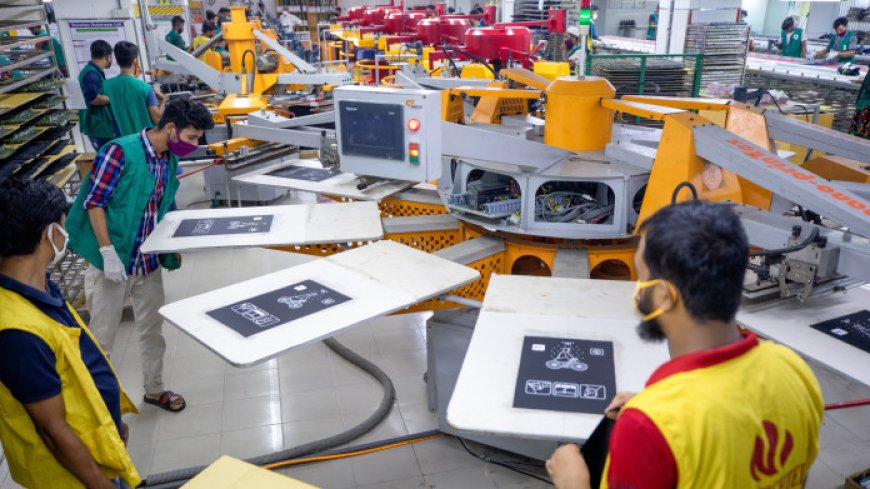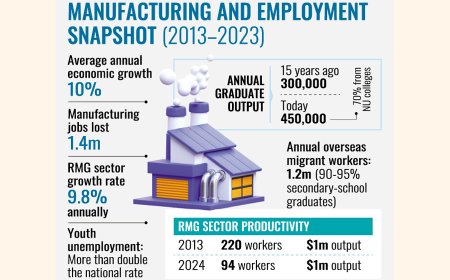Study: 30.58% of RMG Workers Facing Job Losses Due to Automation
The study also stated that most of the workers laid off were helpers.

A study revealed that over 30% of Bangladesh’s RMG workers lost their jobs across various production processes due to automation. It also highlighted that most of those laid off were helpers. Furthermore, the automation process has led to a decline in the number of women, older workers, those with lower literacy, unskilled workers, and workers with low confidence in the sector.
The study, titled "Assessment of Technological Transition in the Apparel Sector of Bangladesh and Its Impact on Workers," was jointly conducted by the Bangladesh Labour Foundation (BLF), Solidaridad Network Asia, and Brac University, and was published on Sunday. It surveyed 429 workers from Dhaka, Gazipur, and Narayanganj between August and October 2024.
The research found that the sweater factory sector experienced the greatest decline, with a 37.03% reduction in workers per production line, while woven factories saw a slightly smaller reduction of 27.23%. The cutting process recorded the highest worker reduction, at 48.34%, while the sewing process had a lower decline of 26.57%.
The executive summary of the study raises concerns about the "Just Transition" concept, emphasizing the impact of reduced worker needs due to automation.
Miran Ali, a member of the BGMEA Support Committee, noted that external inefficiencies such as power shortages, port congestion, and road traffic have negatively affected worker efficiency. He suggested that improving these inefficiencies could boost worker productivity, and highlighted the potential for partial automation to improve both productivity and worker health safety.
Ali also recommended that the government focus on introducing automation not only in production processes but also within its own institutions, including the Labour Ministry, to enhance sector-wide efficiency.
AHM Shafiquzzaman, secretary of the Ministry of Labour and Employment, stated that adopting new technology is essential to improving worker efficiency. He emphasized the government's plans to promote employment through technological development and policy measures aimed at aligning human resource development with industry needs. Shafiquzzaman also pointed out that with 2.5 million people entering the job market annually, academic curriculums must be designed to meet market demands. He suggested that proper training to adapt to new technologies could help prevent job losses due to automation.
Addressing the Ashulia unrest, Shafiquzzaman questioned why it occurred despite several demands being met, stating that the government would take strict action against any conspiracies against the sector. He stressed the importance of safeguarding the RMG industry for the next 20 years to ensure the country's economic stability.
Syed Sultan Uddin Ahmed, executive director of the Bangladesh Institute of Labour Studies and chairman of the Labour Reform Commission, acknowledged that future challenges from full automation cannot be avoided, urging the need for technological adaptation to remain competitive in the global market.
The study also explored the positive impacts of automation, such as increased production efficiency, better quality, and reduced physical strain for workers. 85% of the workers interviewed reported a reduction in physical strain due to automation.
The study recommends a coordinated approach among factories, training institutions, brands, buyers, business associations, government, and development partners to ensure that the benefits of automation reach everyone in the industry. It suggests creating a strategic plan for sustainability, ensuring a just transition for workers, and establishing structured training programs for both workers and mid-level management.
To attract future talent, the study proposes introducing internship programs in collaboration with Technical Education Institutes. It also calls on brands and buyers to ensure ethical trading practices, fair wages, safe working conditions, and respect for labor rights throughout the automation process.
Additionally, it recommends that trade unions collaborate with employers, employers' associations, brands, the government, and civil society organizations to develop capacity-building programs for workers transitioning to new roles in automated environments.
The study further suggests that the government develop a National Plan of Action focused on a just transition, prioritizing worker welfare, job creation, skill development, and social security for those affected by automation.
What's Your Reaction?



















































































